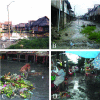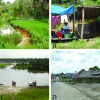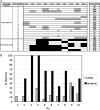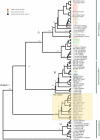Determining risk for severe leptospirosis by molecular analysis of environmental surface waters for pathogenic Leptospira
- PMID: 16933963
- PMCID: PMC1551915
- DOI: 10.1371/journal.pmed.0030308
Determining risk for severe leptospirosis by molecular analysis of environmental surface waters for pathogenic Leptospira
Abstract
Background: Although previous data indicate that the overall incidence of human leptospirosis in the Peruvian Amazon is similar in urban and rural sites, severe leptospirosis has been observed only in the urban context. As a potential explanation for this epidemiological observation, we tested the hypothesis that concentrations of more virulent Leptospira would be higher in urban than in rural environmental surface waters.
Methods and findings: A quantitative real-time PCR assay was used to compare levels of Leptospira in urban and rural environmental surface waters in sites in the Peruvian Amazon region of Iquitos. Molecular taxonomic analysis of a 1,200-bp segment of the leptospiral 16S ribosomal RNA gene was used to identify Leptospira to the species level. Pathogenic Leptospira species were found only in urban slum water sources (Fisher's exact test; p = 0.013). The concentration of pathogen-related Leptospira was higher in urban than rural water sources (approximately 10(3) leptospires/ml versus 0.5 x 10(2) leptospires/ml; F = 8.406, p < 0.05). Identical 16S rRNA gene sequences from Leptospira interrogans serovar Icterohaemorrhagiae were found in urban slum market area gutter water and in human isolates, suggesting a specific mode of transmission from rats to humans. In a prospective, population-based study of patients presenting with acute febrile illness, isolation of L. interrogans-related leptospires from humans was significantly associated with urban acquisition (75% of urban isolates); human isolates of other leptospiral species were associated with rural acquisition (78% of rural isolates) (chi-square analysis; p < 0.01). This distribution of human leptospiral isolates mirrored the distribution of leptospiral 16S ribosomal gene sequences in urban and rural water sources.
Conclusions: Our findings data support the hypothesis that urban severe leptospirosis in the Peruvian Amazon is associated with higher concentrations of more pathogenic leptospires at sites of exposure and transmission. This combined quantitative and molecular taxonomical risk assessment of environmental surface waters is globally applicable for assessing risk for leptospiral infection and severe disease in leptospirosis-endemic regions.
Conflict of interest statement
Figures






References
-
- World Health Organization. Leptospirosis worldwide, 1999. Wkly Epidemiol Rec. 2001;76:109–116. - PubMed
-
- Bharti AR, Nally JE, Ricaldi JN, Matthias MA, Diaz MM, et al. Leptospirosis: A zoonotic disease of global importance. Lancet Infect Dis. 2003;3:757–771. - PubMed
-
- Pate GE, Hogan MC, FitzSimon N, Mellotte GJ. A review of the epidemiology of leptospirosis in the Republic of Ireland. Ir Med J. 2000;93:114–117. - PubMed
-
- Vinetz JM, Glass GE, Flexner CE, Mueller P, Kaslow DC. Sporadic urban leptospirosis. Ann Intern Med. 1996;125:794–798. - PubMed
Publication types
MeSH terms
Substances
Associated data
- Actions
- Actions
- Actions
- Actions
- Actions
- Actions
- Actions
- Actions
- Actions
- Actions
- Actions
- Actions
- Actions
- Actions
- Actions
- Actions
- Actions
- Actions
- Actions
- Actions
- Actions
- Actions
- Actions
- Actions
- Actions
- Actions
- Actions
- Actions
- Actions
- Actions
- Actions
- Actions
- Actions
- Actions
- Actions
- Actions
- Actions
- Actions
- Actions
- Actions
- Actions
- Actions
- Actions
- Actions
- Actions
- Actions
- Actions
- Actions
- Actions
- Actions
- Actions
- Actions
- Actions
- Actions
- Actions
- Actions
- Actions
Grants and funding
LinkOut - more resources
Full Text Sources
Molecular Biology Databases
Research Materials

